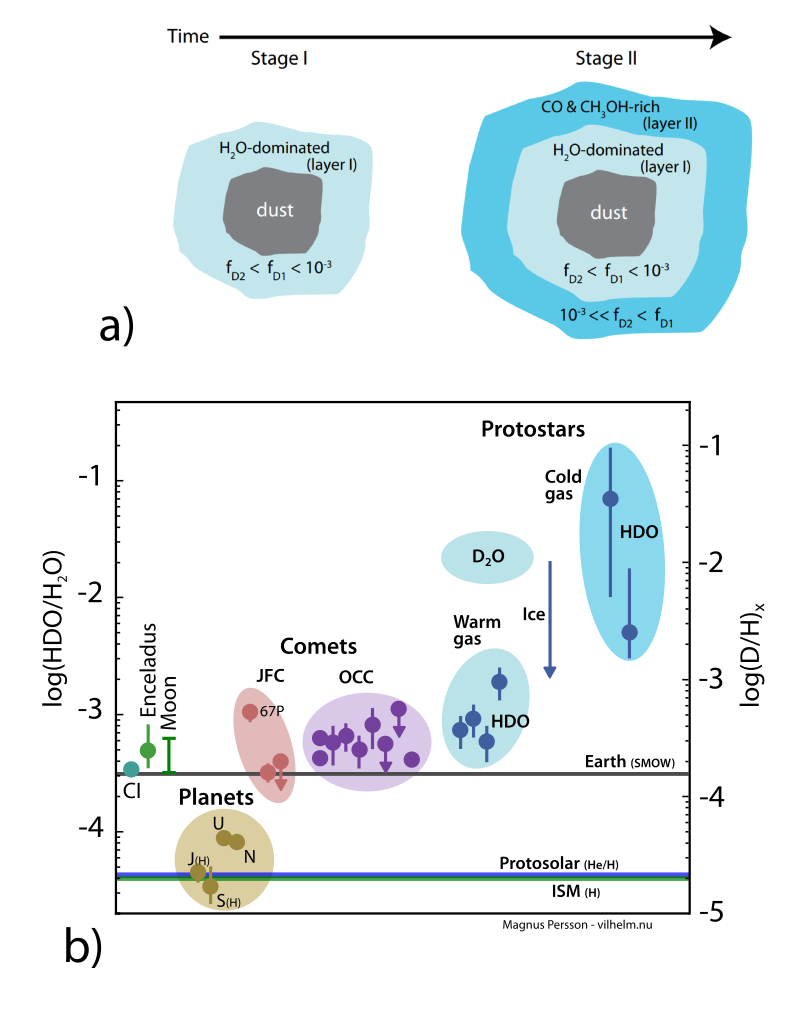| EPoS Contribution |
|
A complete picture of water deuteration in deeply-embedded low-mass protostars
Magnus Persson Leiden Obs, Leiden, NL | |
|
The importance of water for various processes and in various
environments in star forming regions have been of interest for a
long time. Linking the chemical evolution of water to Solar System
objects and the delivery of water to Earth is an important task in
astrochemistry. In the past few years Spitzer and Herschel from space,
and various ground based radio interferometric facilities, such as
SMA, NOEMA and of course ALMA have improved our understanding of the
chemical evolution of water in star formation.
One particulary important tracer of the formation conditions and the chemical evolution of water is the deuterium fractionation (D/H-ratio). Specifically both the singly deuterated water HDO, and doubly deuterated water D2O in comparison to the non-deuterated form, H2O. The water deuteration in the inner warm regions, where the water ice is fully sublimated, is assumed to represent the bulk ice value. Indee, the HDO/H2O ratio in the warm gas is has been found to be similar to Solar System comets, lending support to little chemical processing of water between the early stages of protostellar evolution and incorporation into icy planetesimals. The cold outer regions in envelopes of deeply-embedded low-mass protostars show HDO/H2O ratios roughly an order of magnitude higher than in the inner warm (>100 K) regions. Surprisingly, it was shown that D2O/HDO ~ 7x HDO/H2O in the same warm gas toward the two sources observed so far. This is opposite to what was previously expected. An explanation to these three observational results was recently suggested where the differences in the ratio could be understood. The analytical model developed shows that the observed ratios are a natural consequence of chemical evolution in the early cold stages of low-mass star formation. This last piece of the puzzle has increased our understanding of the general chemical evolution of low-mass protostars. In this talk I will present the various observations and models leading up to this. I will also present some of our future plans for validating and extending the model. The potential discussion points are e.g. further tests/developments of models, extrapolation to other environments/evolutionary stages etc. | |
 | |
| Caption: The top figure, a) shows the schematic view of the astrochemical model schenario. In the first stage (I) deuteration is inefficient. At the second stage (II) the deuteration is efficient. This layer has a higher amount of deuterated water. The bottom figure, b) shows some the observations of various deeply-embedded prototstars, Solar System objects (comets, planets, the moon etc) where a D/H ratio has been estimated. The HDO/H2O ratio for the warm gas is significantly lower than for the cold gas. The D2O/HDO ratio is much higher than the HDO/H2O ratio for the warm gas. | |
| Collaborators: A. Coutens, UCL, GB K. Furuya, Sterrewacht, NL E. van Dishoeck, Leiden Obs/MPE, NL/DE J.K. Jørgensen, StarPlan/NBI, DK |
Key publication
Suggested Session: Chemistry |

